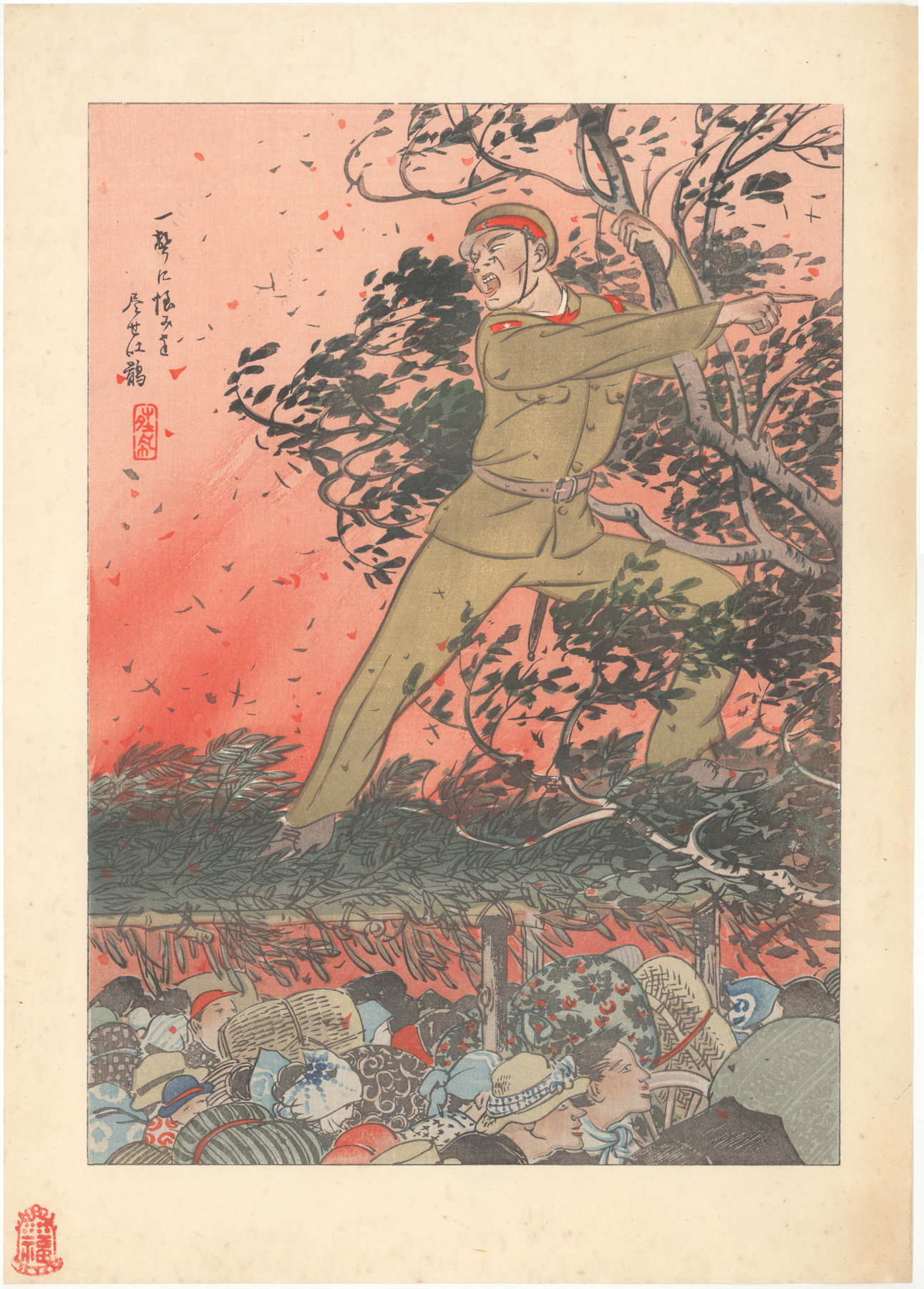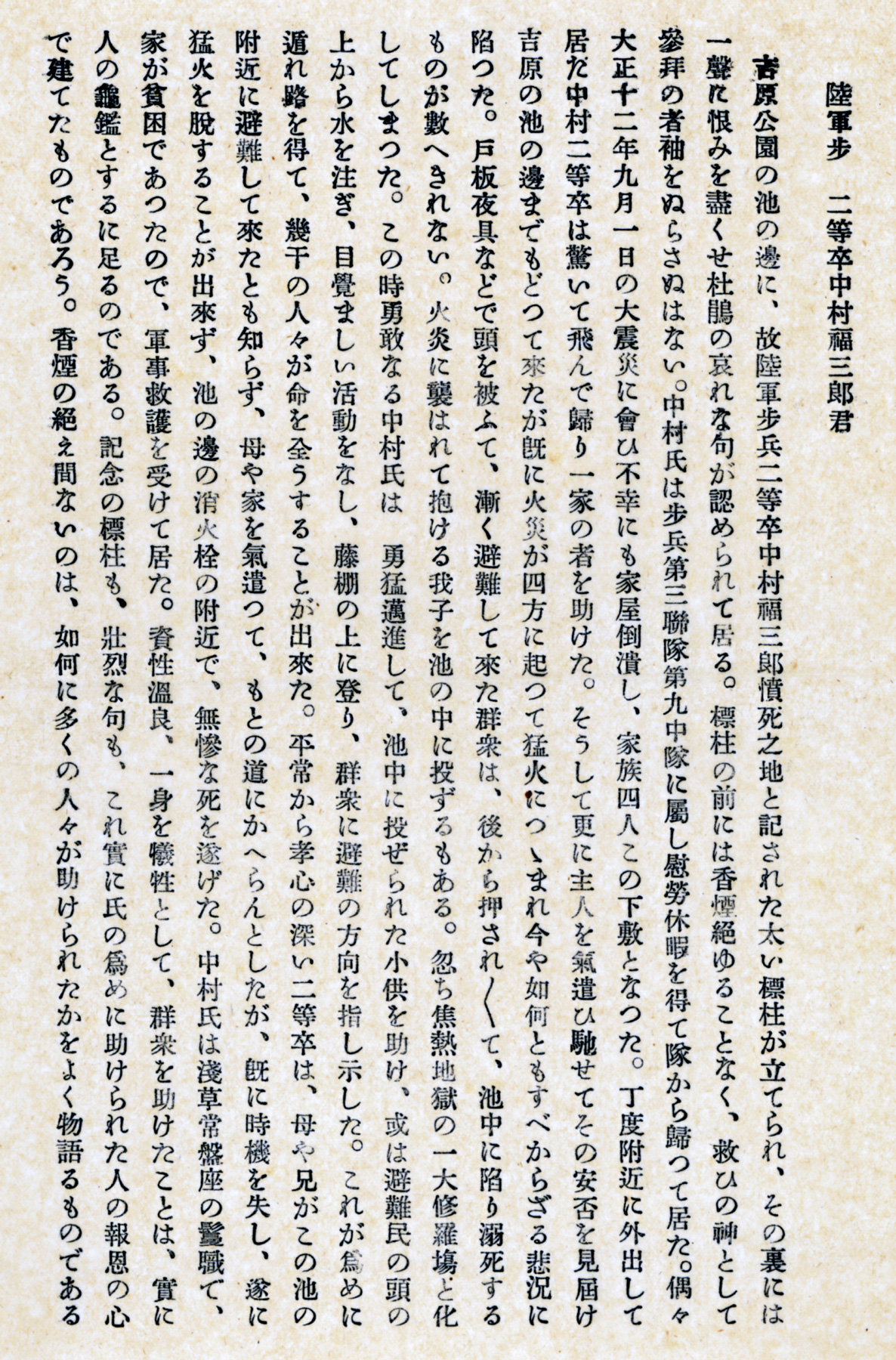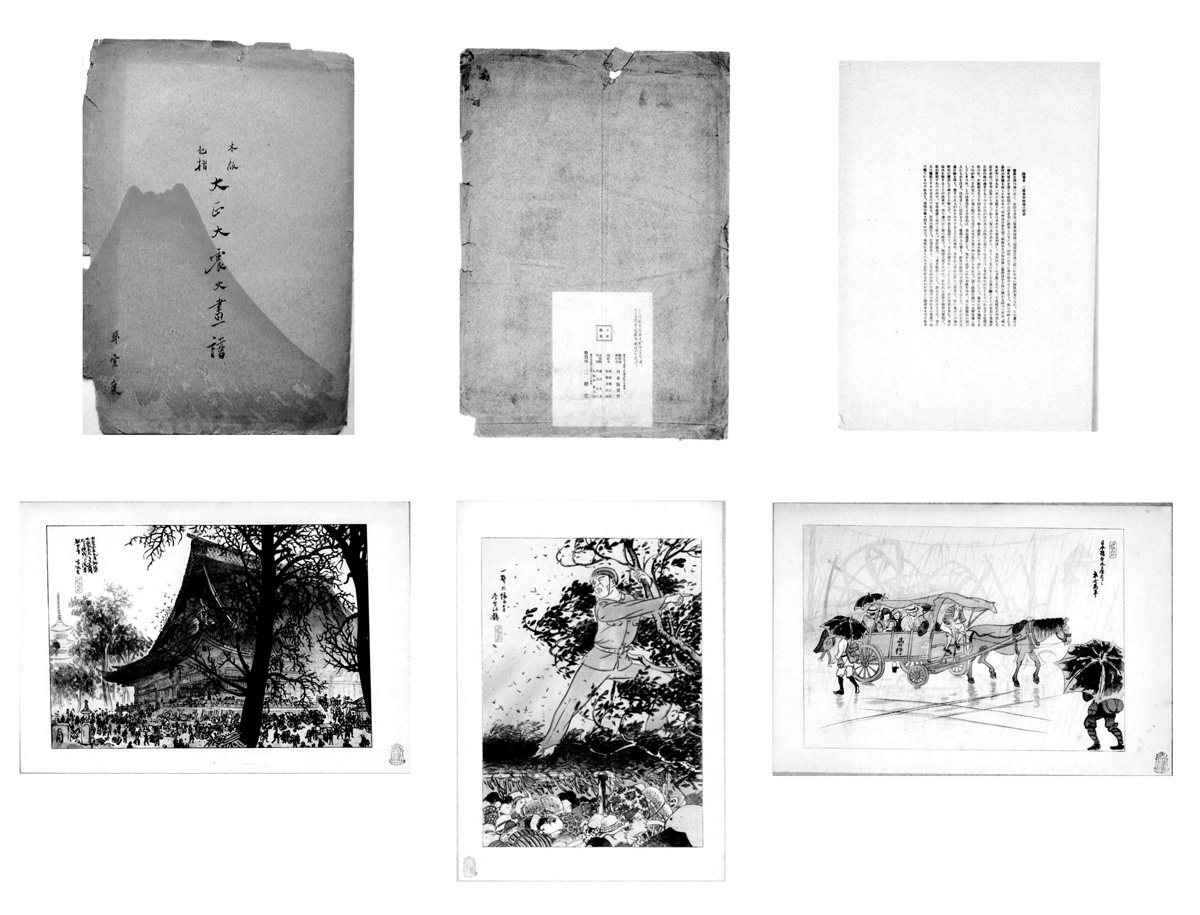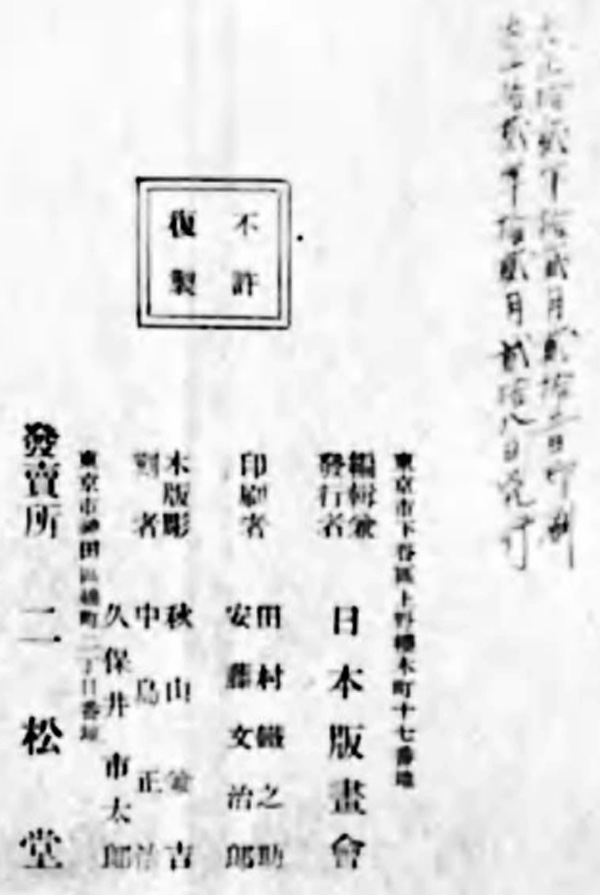About This Print
The bravery of Private Nakamura Fukusaburō is depicted, rushing to help the people trapped near Yoshiwara Pond as the firestorm that engulfed Tokyo after the 1923 Great Kantō Earthquake rages. The inscription to the left of Private Nakamura reads:一聲に恨みを・尽せ杜鵑
Issei ni urami wo tsukuse hototogisu
Cuckoo! With one voice, exhaust your regrets!
Source: with thanks to Dr. Maribeth Graybill, The Arlene and Harold Schnitzer Curator of Asian Art, Portland Art Museum
At the edge of the pond in Yoshiwara Park, there is a large signpost inscribed, "Site of the Army Foot Soldier Private Second Class Nakamura Fukusaburō’s funsh (death in a fit of anger or indignation),” and on the reverse we discern the pitiful/sad verse, Cuckoo! With one voice, exhaust your regrets! In front of the post, incense is always burning; pilgrims who venerate [Nakamura] as sukui no kami (god of aid/help) all have damp sleeves (from their tears). Mr. Nakamura was a member of the Foot Soldiers (?Infantry) Third Regiment, Ninth Company. Having been granted leave in honor of his services, he had returned [home]. By sheer coincidence, [he] encountered the Great Earthquake of September 1, 1923. His house collapsed, burying four members of his family.
Just [at that time], Private Second Class Nakamura had gone out; astonished, he rushed home and helped his family. Then, giving thought to his landlord, he went to check on his safety. [By the time he] returned to the bank of the Yoshiwara Pond, the fire was burning on all four sides. Surrounded by flames, there was nothing he could do. Gradually, crowds [fleeing the fire], covering their heads with wood planks or bedclothes [gathered at the pond]. As they kept pushing and pushing, and it was impossible to count the number who drowned in the pond. Under attack by the fire, there were those who threw their own children into the pond. All of a sudden, the area turned into a scene of carnage like the Hell of Fiery Heat [one of the Eight Buddhist Hells]. Then, the courageous Mr. Nakamura, with great valor, saved the children that had been thrown into the pond, poured water over the heads of the refuges [those who had escaped to the park], carrying out remarkable feats. He climbed on a wisteria trellis to point out the direction where the masses could escape. Because of this, several thousand lives were saved. The usually filial Private Second Class, not realizing that his own mother and elder brother had come to this spot when they fled the fire, attempted to return to his home, but the opportunity [to do so] was lost; it was no longer possible to escape from the intense flames. He died tragically near a fire hydrant at the edge of the pond. Mr. Nakamura was a 髪職 (hairdresser?) at the Asakusa Tokiwaza Theater, and because his family was poor, he was receiving military relief [assistance from the military]. [For one of] his gentle nature to sacrifice himself to help the many is truly a model for all. The memorial post and the heroic verse were probably erected out of the gratitude of the many he saved. The ever-present incense also testifies to the great numbers that he rescued.
説明文有 setsumeibun ari
Explanatory Text included with print
click on image to enlarge
About the Album
I have not been able to confirm how many prints were issued as part of Color Woodblock Picture Album of the History of the Taishō Great Earthquake, Collection 1 or whether their were subsequent collections issued. The information that is available can be found on the National Diet Library website. The NDL displays three prints, a single explanatory sheet (for the Private Nakamura print), and the front and back of a dismembered envelope which contained the prints. A colophon is pasted to the back of the envelope. (See details below.) It is not known whether the three prints the NDL shows are all that were originally contained in the envelope. In addition to the three prints shown, a fourth print, belonging to this collection, Evacuees in the Suburbs of Tokyo, is known.Unfortunately, the NDL reproduction of the colophon is not clear and can only be partially read, as shown below.
編輯兼 発行者 日本版畫會 Editor and Publisher: Nihon hangakai [Japan Print Association, preceded by Tokyo address]
印刷者 田村鐵之助 安?女治郎 Printers: Tamura Tetsunosuke (1853-1925) and unread
刻者 中島正尚 久保井市太郎 Engravers: unread and Kuboi Ichitarō
東京市神田區錦町二丁目十番地 發賣所 二松堂 Sales Office: Nishōdō [preceded by Tokyo address]
image source: National Diet Library website
Strangely, the colophon does not contain Fukunaga Seihan's name 福永晴帆 and neither the NDL or the Tokyo Metropolitan Library, which shows a single print, that of Private Nakamura, lists him as the creator. The presence of two seals appearing on all four prints reading 晴帆 (seihan) and 福 (fuku), coupled with the information contained in the magazine The Studio: An Illustrated Magazine of Fine and Applied Art,which positively attributes the prints to him, establishes Fukunaga, best known for his paintings of sliding screens, as the artist.
Print Details
| IHL Catalog | #1007 |
| Title or Description | 吉原公園 / 陸軍歩 二等卒中村福三郎君 Yoshiwara kōen / Rikugunpo nitōsotsu Nakamura Fukusaburō kun Yoshiwara Park: Army Foot Solider Private Second Class Mr. Nakamura Fukusaburō |
| Series | 木版色摺 大正大震史畫譜 第壱集 Taishō daishinshi gafu mokuhan irozuri daiichishū Color Woodblock Picture Album of the History of the Taishō Great Earthquake, Collection 1 also transcribed as 木版色摺 大正大震火画譜. 第壱集 Taishō daishinka gafu mokuhan irozuri daiichishū |
| Artist | Fukunaga Seihan (1884-1961) |
| Signature | not signed |
| Seal |   left: seal reading 晴帆 Seihan left: seal reading 晴帆 Seihanright: 福 (in seal script) [possibly a seal of the artist Fukunaga Seihan or, simply a seal of "good fortune".] |
| Publication Date | 1923 (Taishō 12) |
| Publisher | 日本版畫會 Nihon hangakai [Japan Print Association] |
| Carver | |
| Printer | |
| Impression | excellent |
| Colors | excellent |
| Condition | good - minor foxing and toning; full-size sheet |
| Genre | shin hanga |
| Miscellaneous | |
| Format | oban |
| H x W Paper | 14 9/16 x 10 3/8 in. (37 x 26.4 cm) |
| H x W Image | 12 1/16 x 8 1/2 in. (30.6 x 21.6 cm) |
| Literature | |
| Collections This Print | Tokyo Metropolitan Library 0372-C4-2/東C0372-C004-002; National Diet Library Call Number 特280-22y |
5/21/2021
10/30/2020
10/8/2020





